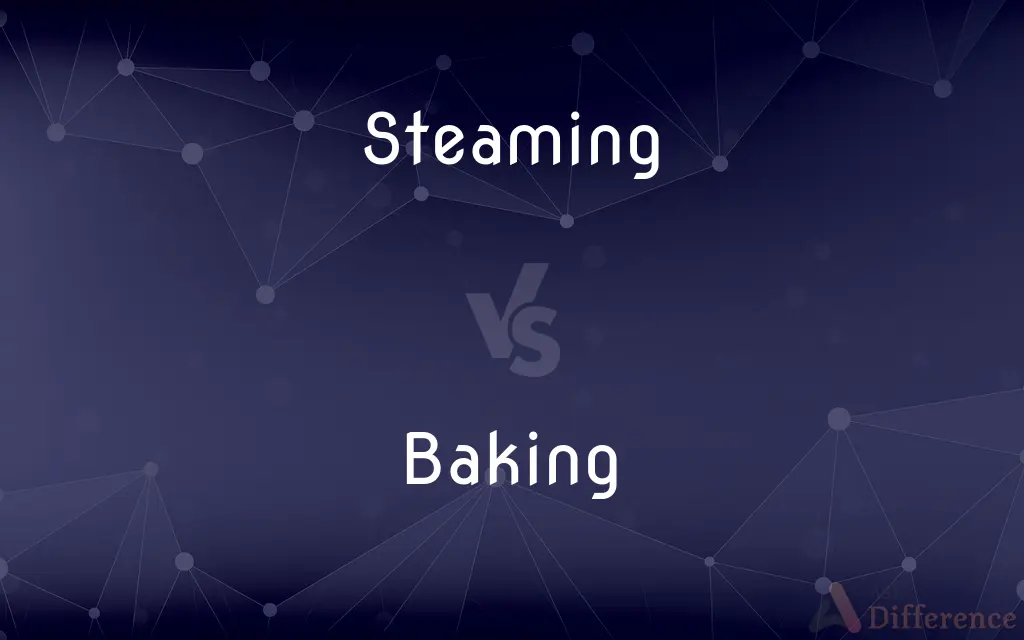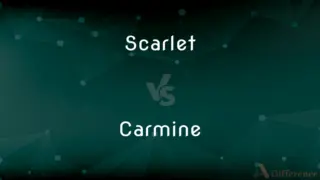Steaming vs. Baking — What's the Difference?
Edited by Tayyaba Rehman — By Urooj Arif — Updated on March 19, 2024
Steaming cooks food using vaporized water, preserving moisture and nutrients, while baking uses dry heat in an oven, creating a crispy exterior and complex flavors.

Difference Between Steaming and Baking
Table of Contents
ADVERTISEMENT
Key Differences
Steaming involves cooking food by surrounding it with steam, typically in a covered pot or steamer. This method gently cooks the food, preserving its moisture, texture, and nutrients. On the other hand, baking exposes food to dry heat in an oven, cooking it evenly and often resulting in a browned or crispy exterior. Baked goods also tend to have more complex flavors due to the Maillard reaction and caramelization.
While steaming is primarily used for vegetables, fish, and dumplings, offering a healthier cooking option by retaining more vitamins and minerals, baking is versatile, suitable for a wide range of foods including bread, pastries, meats, and vegetables. Whereas steaming preserves the food's natural flavors and colors, baking can enhance and transform flavors and textures, creating new taste profiles.
Steaming requires minimal added fats, making it a lower-calorie cooking method compared to baking, where fats are often added to the ingredients. This makes steaming a preferred choice for those on a calorie-restricted diet. Conversely, the fats used in baking contribute to the rich flavors and textures of baked goods, which can be more indulgent.
Equipment for steaming is relatively simple and consists of a steamer basket or insert that can be used with existing pots. Baking, however, requires an oven and specific bakeware designed for even heat distribution and airflow. This difference in equipment can affect the ease of cooking and the types of recipes that can be prepared.
The time required for steaming is generally shorter than baking, as the direct contact with hot steam quickly cooks the food. Baking times are longer due to the indirect heat method, allowing for the development of textures and flavors over time. This fundamental difference in cooking time reflects the distinct natures of each method.
ADVERTISEMENT
Comparison Chart
Heat Source
Vaporized water
Dry heat in an oven
Typical Foods
Vegetables, fish, dumplings
Breads, pastries, meats, vegetables
Nutrient Retention
High, preserves more vitamins and minerals
Lower, some nutrients may be lost
Flavor and Texture
Preserves natural flavors and textures
Can enhance and transform flavors and textures
Added Fats
Minimal to none required
Often requires added fats
Equipment
Steamer basket or insert
Oven and specific bakeware
Cooking Time
Generally shorter
Longer, depending on the recipe
Compare with Definitions
Steaming
Requires no added fats, making it a healthier option.
Steaming fish is a low-calorie method of cooking.
Baking
Cooking food through dry heat in an oven, often leading to a crispy exterior.
Baking bread results in a crunchy crust and soft interior.
Steaming
Ideal for delicate foods like vegetables and fish.
Steamed vegetables retain more of their original texture and taste.
Baking
Requires an oven and various bakeware for different foods.
Using a baking stone for pizza mimics a professional oven's bottom.
Steaming
Cooking food with steam to preserve moisture and nutrients.
Steaming broccoli preserves its color and nutrients.
Baking
Versatile, used for bread, pastries, meats, and more.
Baked chicken thighs have a deliciously crispy skin.
Steaming
Uses a steamer basket or insert over boiling water.
I use a bamboo steamer for dumplings to add a subtle flavor.
Baking
Enhances flavors through the Maillard reaction and caramelization.
Baking cookies brings out a rich, complex taste.
Steaming
Quick, as steam directly contacts food.
Steaming carrots takes just minutes, preserving their crunch.
Baking
Longer, allowing flavors and textures to develop.
Baking a lasagna thoroughly heats and melds its layers.
Steaming
Steaming is a method of cooking using steam. This is often done with a food steamer, a kitchen appliance made specifically to cook food with steam, but food can also be steamed in a wok.
Baking
Baking is a method of preparing food that uses dry heat, typically in an oven, but can also be done in hot ashes, or on hot stones. The most common baked item is bread but many other types of foods are baked.
Steaming
Hot water vapor produced especially by boiling liquid water.
Baking
To cook (food) with dry heat, especially in an oven.
Steaming
Hot, pressurized water vapor used for heating, cooking, or to provide mechanical power.
Baking
To harden or dry (something) by subjecting to heat in or as if in an oven
Bake bricks.
Steaming
Power generated by the expansion of boiling water as it turns to vapor
An engine at full steam.
Baking
To cook food with dry heat.
Steaming
Steam heating.
Baking
To become hardened or dry by or as if by having been subjected to the heat of an oven.
Steaming
Condensed water vapor in the form of a mist or cloud
The steam from the teakettle.
The steam of the oxen's breath in the cold air.
Baking
The act or process of baking.
Steaming
Power; energy
The fundraising effort ran out of steam.
Baking
An amount baked.
Steaming
To produce or emit steam
The kettle is steaming. Let's make tea.
Baking
A social gathering at which food is cooked by baking and then served.
Steaming
To become or rise up as steam
The rain steamed off the hot pavement.
Baking
Present participle of bake.
Steaming
To become misted or covered with steam
The bathroom mirror steamed over.
Baking
That bakes.
Baking bread; baking clay
Steaming
To move by means of steam power.
Baking
(figuratively) Of a person, an object, or the weather: very hot; boiling, broiling, roasting.
I'm baking – could you open the window?
The car was baking after having been parked in the sun the whole afternoon.
Steaming
(Informal) To become very angry; fume.
Baking
An action in which something is baked.
I'm going to do some baking this afternoon.
Steaming
To expose to steam, as in cooking.
Baking
The way in which something is baked.
Steaming
To cover or mist with steam
The windows are steamed up.
Baking
(countable) The production of a batch of baked product.
Steaming
(Informal) To make angry
His laziness really steams me.
Baking
The act or process of cooking in an oven, or of drying and hardening by heat or cold.
Steaming
The action of steam on something.
Baking
The quantity baked at once; a batch; as, a baking of bread.
Steaming
The method of cooking by immersion in steam.
Baking
Making bread or cake or pastry etc.
Steaming
A form of robbery in which a large gang moves swiftly and violently through a bus, train, etc.; see Steaming (crime).
Baking
Cooking by dry heat in an oven
Steaming
Relating to the ability of a steam locomotive (etc.) to raise steam.
Baking
As hot as if in an oven
Steaming
Giving off steam.
We were served with steaming bowls of soup.
Steaming
(slang) Very angry.
I was steaming when I heard about their betrayal.
Steaming
Extremely drunk.
Steaming
Present participle of steam
Steaming
Emitting moisture in the form of vapor or mist;
A steaming kettle
Steaming towels
Steaming
(used of heat) extremely;
The casserole was piping hot
Common Curiosities
Which is healthier, steaming or baking?
Steaming is generally considered healthier because it preserves more nutrients and requires less or no added fats.
What is steaming?
Steaming is a cooking method that uses steam to gently cook food, preserving its moisture and nutrients.
How do I choose between steaming and baking?
Choose based on the desired outcome: steaming for moist, tender dishes, or baking for crispy textures and complex flavors.
Can I steam bread?
Certain types of bread, like Chinese steamed buns, are made through steaming, offering a soft, moist texture.
What does baking do to food?
Baking cooks food through dry heat in an oven, often resulting in a browned, crispy exterior and complex flavors.
Can baking be done in a microwave?
Some baking can be adapted for microwaves, but results may vary from traditional oven baking.
Why does baking enhance flavor?
Baking enhances flavor through the Maillard reaction and caramelization, which develop rich and complex taste profiles.
What are the disadvantages of steaming?
Steaming may not be suitable for dishes where a crispy or browned exterior is desired.
Can I bake without an oven?
Traditional baking requires an oven, but some baked goods can be made in alternatives like toaster ovens or specialized baking appliances.
What's the best food to steam?
Vegetables and fish are ideal for steaming, as the method preserves their texture and nutrients.
Is it possible to oversteam food?
Yes, oversteaming can result in overly soft textures and diminished flavors, so timing is important.
Do I need special equipment to steam food?
Basic steaming requires a pot, water, and a steamer basket or insert.
Is steaming faster than baking?
Yes, steaming is generally faster due to the direct contact of steam with food.
How does baking affect vegetables?
Baking can enhance the flavors of vegetables through caramelization, but may lead to some nutrient loss.
Can steaming dry out food?
Steaming is less likely to dry out food compared to dry-heat cooking methods, as it uses moist heat.
Share Your Discovery

Previous Comparison
Responsibility vs. Commitment
Next Comparison
Scarlet vs. CarmineAuthor Spotlight
Written by
Urooj ArifUrooj is a skilled content writer at Ask Difference, known for her exceptional ability to simplify complex topics into engaging and informative content. With a passion for research and a flair for clear, concise writing, she consistently delivers articles that resonate with our diverse audience.
Edited by
Tayyaba RehmanTayyaba Rehman is a distinguished writer, currently serving as a primary contributor to askdifference.com. As a researcher in semantics and etymology, Tayyaba's passion for the complexity of languages and their distinctions has found a perfect home on the platform. Tayyaba delves into the intricacies of language, distinguishing between commonly confused words and phrases, thereby providing clarity for readers worldwide.
















































